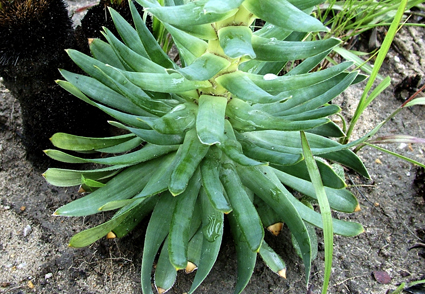Abstract
Paepalanthus cordatus is an endangered species described from a single collection which lacks fully developed inflorescences and flowers. Despite the absence of these characters, the species was unambiguously placed in P. sect. Diphyomene, one of the few groups of Paepalanthus with dimerous flowers and which is mainly distributed in central Brazil. In this manuscript, I provide a full description of the species, detailing and illustrating the fully developed inflorescences and flowers for the first time. The spherical umbel-shaped inflorescence is composed of sets of capitula bearing dimerous flowers; the pistillate flowers have dolabriform sepals and bifid stigmatic branches; the staminate ones have an elongated fleshy anthophore. These characters fully match the current circumscription of P. sect. Diphyomene. Based on the specimens recently collected and additional data, the new conservation status for the species is Endangered instead of Critically Endangered, as previously assessed. I also clarify the inadvertent lectotype selection and previous interpretations of the type specimens. Comments on the species distribution, morphology, and ecology, as well as a geographic distribution map, photos, and a detailed illustration are also provided.
References
BFG (2015) Growing knowledge: an overview of Seed Plant diversity in Brazil. Rodriguésia 66: 1085–1113. http://dx.doi.org/10.1590/2175?7860201566411
Flora do Brasil (2020) Jardim botânico do Rio de Janeiro. Available from: http://www.floradobrasil.jbrj.gov.br/reflora/floradobrasil/FB7558 (accessed 15 June 2021)
Giulietti, A.M. & Hensold, N. (1990) Padrões de distribuição geográfica dos gêneros de Eriocaulaceae. Acta Botanica Brasilica 4: 133–159. https://doi.org/10.1590/S0102-33061990000100010
Giulietti, A.M., Harley, R.M., Queiroz, L.P., Wanderley, M.G.L. & van den Berg, C. (2005) Biodiversidade e conservação das plantas no Brasil. Megadiversidade 1: 52?61.
Giulietti, A.M., Andrade, M.J.G, Scatena, V.L., Trovó, M., Coan, A.I., Sano, P.T., Santos, F.A.R, Borges, R.L.B. & van den Berg, C. (2012) Molecular phylogeny, morphology and their implications for the taxonomy of Eriocaulaceae. Rodriguésia 63: 1?19. https://doi.org/10.1590/S2175-78602012000100001
IUCN (2019) Guidelines for Using the IUCN Red List Categories and Criteria. Version 14. Available from: http://www.iucn.org (accessed 15 June 2021).
Koernicke, F. (1863) Eriocaulaceae. In: Martius, C.F.P. & Eichler, A.W. (eds.) Flora brasiliensis 3 (1). Royal Typography, Munich, pp. 273–508. https://doi.org/10.5962/bhl.title.454
McNeill, J. (2014) Holotype specimens and type citations: General issues. Taxon 63: 1112–1113. https://doi.org/10.12705/635.7
Martius, K.F.P. (1834) Eriocaulaceae. Anales des Sciences Naturelles, Botanique 2: 25–43.
Moldenke, H.N. (1973) Additional notes on the Eriocaulaceae XLVI. Phytologia 26: 226?262. https://doi.org/10.5962/bhl.part.13709
NYBG (2021) Planalto Expeditions. Available from sciweb.nybg.org/science2/hcol/planalto/expeditions.asp.html (accessed 10 October 2021).
Prado, J., Hirai, R.Y. & Moran, R.C. (2015) Proposals concerning inadvertent lectotypifications (and neotypifications). Taxon 64: 651. https://doi.org/10.12705/643.29
QGIS Development Team (2018) QGIS Geographic Information System. Version 3.6. Open Source Geospatial Foundation Project. Available from: https://www.qgis.org (accessed 10 October 2021)
Radford, A.E., Dickson, W.C., Massey, J.R. & Bell, C.R. (1974) Vascular plant systematics. Harper & Row Pub, New York, 891 pp.
Ruhland, W. (1903) Eriocaulaceae. In: Engler, A. (ed.) Das Pflanzenreich. Regni vegetabilis conspectus 4 heft 30. Wilhelm Engelmann, Leipzig, pp. 1–294.
Sano, P.T., Amaro, R. & Serrano, T. (2014) Eriocaulaceae. In: Martinelli, G., Messina, T. & Filho, L.S. (eds.) Livro vermelho da flora do Brasil: plantas raras do cerrado. Andrea Jakobsson, Rio de Janeiro, pp. 104–122.
Silva, A.L., Trovó, M. & Coan, A.I. (2016) Floral development and vascularization help to explain meristem evolution in Paepalanthus (Eriocaulaceae, Poales). PeerJ: 4: e2811. https://doi.org/10.7717/peerj.2811
Stuessy, T.F. (1990) Plant taxonomy, the systematic evaluation of comparative data. Columbia University, Press New York, 562 pp.
Stützel, T. & Trovó, M. (2013) Inflorescences in Eriocaulaceae: taxonomic relevance and practical implications. Annals of Botany 112: 1505–1522. https://doi.org/10.1093/aob/mct234
Thiers, B. (continuously updated) Index Herbariorum: A global directory of public herbaria and associated staff. New York Botanical Garden’s Virtual Herbarium. Available from: http://sweetgum.nybg.org/ih/ (accessed 15 June 2021).
Trovó, M. (2018) Tackling the Paepalanthus elongatus complex (Eriocaulaceae) in central Brazil: nomenclatural changes and description of a new species from Goiás. Phytotaxa 367: 13–24. https://doi.org/10.11646/phytotaxa.367.1.2
Trovó, M. & Sano, P.T. (2010) Taxonomic survey of Paepalanthus section Diphyomene (Eriocaulaceae). Phytotaxa 14: 49–55. https://doi.org/10.11646/phytotaxa.14.1.4
Trovó, M. & Sano, P.T. (2014) Paepalanthus conjunctus, a new species of Paepalanthus sect. Diphyomene (Eriocaulaceae) from Central Brazil. Phytotaxa 178: 53–56. https://doi.org/10.11646/phytotaxa.178.1.7
Trovó, M., Echternacht, L.A. & Sano, P.T. (2013) Distribution and conservation of Paepalanthus Mart. sect. Diphyomene Ruhland (Eriocaulaceae) in Neotropical savannas. Adansonia 35: 195–206. https://doi.org/10.5252/a2013n2a2
Trovó, M., Silva, A.L. & Coan, A.I. (2015) Paepalanthus echinoides (Eriocaulaceae), a new species from central Brazil with notes on leaf and scape anatomy. Phytotaxa 231: 81–88. https://doi.org/10.11646/phytotaxa.231.1.8
Trovó, M., Silva, A.L. & Coan, A.I. (2017) Paepalanthus modestus (Eriocaulaceae), a new dimerous species from Goiás, Brazil, with notes on leaf and scape anatomy. Phytotaxa 316: 271–278. https://doi.org/10.11646/phytotaxa.316.3.6
Turland, N.J., Wiersema, J.H., Barrie, F.R., Greuter, W., Hawksworth, D.L., Herendeen, P.S., Knapp, S., Kusber, W.H., Li, D.Z., Marhold, K., May, T.W., McNeill, J., Monro, A.M., Prado, J., Price, M.J. & Smith, G.F. (Eds.( (2018) International Code of Nomenclature for algae, fungi, and plants (Shenzhen Code) adopted by the Nineteenth International Botanical Congress Shenzhen, China, July 2017. Regnum Vegetabile 159. Koeltz Botanical Books, Glashütten, 254 pp. https://doi.org/10.12705/Code.2018
Weberling, F. (1989) Morphology of flowers and inflorescences. Cambridge University Press, Cambridge, 423 pp.


